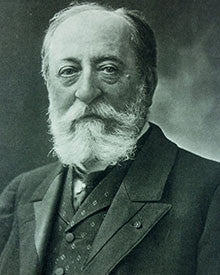
(1835 - 1921)
Born less than a decade after the death of Beethoven, and still composing three years after that of Debussy, Saint-Saëns lived through the Romantic movement as a Classicist of boundless skill, energy and knowledge. His prolific output and his artistic beliefs held firm to timeless principles of beauty and form. As a result his music never seemed to grow old-fashioned (except to card-carrying Wagnerians) and by the end, when a generation of neo-Classicists was on the rise and Saint-Saëns had turned to elegantly elliptical woodwind sonatas, it had started to sound contemporary all over again. He had been a Parisian child prodigy, entering the Conservatoire at 13 to study organ and composition. His fluency stayed with him as his abilities flowered. An inquiring mind developed, taking in lasting interests from literature to astronomy. His five piano concertos show his characteristic qualities at their finest: suave melody and incisive articulation, orchestral clarity and colour, an often original use of conventional forms, and an expressive idiom that lives at the nerve-ends, generating unstoppable verve and, occasionally, great intensity, without lingering over the more profound moments.
Camille Saint-Saëns Composition Timpani and Percussion Requirements
Carnival of the Animals
No Timpani + 2 percussion
Xylophone, glockenspiel (glass harmonica)
__________________________________________________________________________________
Symphony No 3
Timpani
Int'l 32/29/26 Prem 32/30/28
3 percussion
Orchestral bass drum, triangle, clash cymbals
__________________________________________________________________________________
